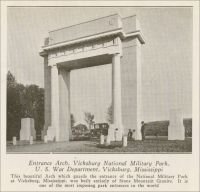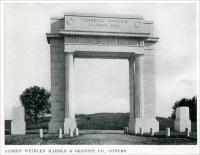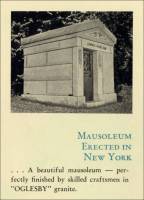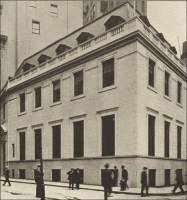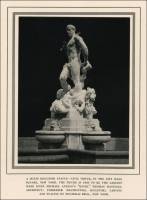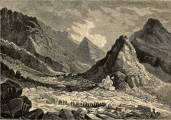


Structures and Monuments in Which Georgia Stone was Used
- Finished Products from Georgia Stone in Mississippi
- Mississippi – the Elliott Mausoleum erected in Mississippi. Blue “Oglesby” granite from the Oglesby granite quarries at Elberton, Georgia, was used in the construction of the Elliott mausoleum. The following photograph is from Oglesby Blue Granite Mausoleum Catalog, Oglesby Granite Quarries, Elberton, Georgia, 1937.
- Jackson, Mississippi - the Mississippi
State Capitol (photographs and
history)
The exterior of the State Capitol is of Georgia granite, foundation concrete walls, Bedford limestone. In the Rotunda the walls are of Italian marble. Chamber is part marble with the base of Belgium black marble, columns are Breccia Violet with Corinthian caps. In the House of Representatives the walls are art marble with the base of Belgium black marble.
- Oxford, Mississippi – the Gertude Castellow Ford Center for the Performing Arts at the University of Mississippi.
(The link from which the following information was obtained is no longer available on the Gertrude Castellow Ford Center for the Performing Arts web site.)
<http://www.olemiss.edu/fordcenter/tours.html>Georgia marble was used for the floor of the lobby in the Center.
-
Vicksburg, Mississippi – the Louisiana State Monument (from “Two New Vicksburg Battle Memorials” Government Memorial Arch and Louisiana State Monument Dedicated, in The Monumental News, Vol. XXXIII, No. 5, May 1921, pp. 351)
“The Louisiana memorial is a lofty fluted Doric column surmounted by a funeral urn…The shaft is 82 feet high on a base 24 feet square, and was executed in Stone Mountain granite, by the Stone Mountain Granite Corporation, Stone Mountain, Georgia, for the Albert Weiblen Marble and Granite Co., of New Orleans, the contractor for the work. It was designed by Charles L. Lawhon, designer for this firm. It was erected by the state of Louisiana, and cost $50,000.”
-
Vicksburg, Mississippi – the Vicksburg National Military Park – the Entrance Arch (from Southeast Granite Company – Stone Mountain Memorials/Monumental Stones Catalog, 1920s.
“Entrance Arch, Vicksburg National Military Park, U. S. War Department, Vicksburg, Mississippi – This beautiful Arch which guards the entrance of the National Military Park at Vicksburg, Mississippi, was built entirely of Stone Mountain Granite. It is one of the most imposing park entrances in the world.”
- Vicksburg, Mississippi – the Vicksburg National Military Park – the Entrance Memorial Arch (from “Two New Vicksburg Battle Memorials” Government Memorial Arch and Louisiana State Monument Dedicated, in The Monumental News, Vol. XXXIII, No. 5, May 1921, pp. 351)
“The (Vicksburg National Military Park) memorial arch was also designed by Mr. Lawhon and erected by the same firm (Albert Weiblen Marble and Granite Co., of New Orleans). It is a classic structure of correct proportions and details, and is also of Stone Mountain granite….” (from Stone Mountain, Georgia)
- Vicksburg, Mississippi – the Vicksburg National Military Park – the Entrance Memorial Arch (from “Two New Vicksburg Battle Memorials” Government Memorial Arch and Louisiana State Monument Dedicated, in The Monumental News, Vol. XXXIII, No. 5, May 1921, pp. 351)
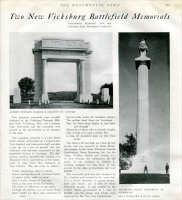

“Two New Vicksburg Battle Memorials,” in “The Monumental News,” May 1921, pp. 351
“Louisiana State Monument at Vicksburg. Albert Weiblen Marble & Granite Co., Contractors.” (Mississippi)
- Finished Products from Georgia Stone in Missouri
- Kansas City, Missouri - the Forrest Hill Mausoleum (from The Story of Georgia Marble, possibly published by the Georgia Marble Co., no date of publication.)
Georgia marble was used in the construction of the Forrest Hill Mausoleum (no cemetery listed).
- Rolla, Missouri – the University of Missouri-Rolla Stonehenge (The following information is presented on the university web site.)
UMR’s Stonehenge Some Answers, File Date: 4 January 1996, The Building of the UMR Stonehenge, The Missouri Megalith - Some Questions Answered, by Dr. David A. Summers. (The link from which the following information was obtained is no longer available.)
<http://rockmech.umr.edu/stonehenge/answerspage1.html>“The UMR-Stonehenge is made of granite which was quarried in Elberton, Georgia.”
- Southwest City (west of), Missouri - the John Ridge Memorial - This information was taken from excerpts from The Chronicles of Oklahoma, Vol. 13, No. 2, June 1935 Notes, pp. 228, presented by the Oklahoma Historical Society.
According to this article, the marker for John Ridge was made of Georgia marble.
- St. Joseph, Missouri – the Geiger Memorial (from The Story of Georgia Marble, no date of publication, pp. 21)
- Kansas City, Missouri - the Forrest Hill Mausoleum (from The Story of Georgia Marble, possibly published by the Georgia Marble Co., no date of publication.)
- Finished Products from Georgia Stone in Nebraska
- Lexington, Dawson County, Nebraska - the Dawson County Courthouse - The following information was presented by the Dawson County Nebraska Clerk of District Court. The link from which the following information was obtained is no longer available.)
<http://www.dawsoncdc.ne.gov/history3.html>The Dawson County Courthouse was completed in 1914, and Georgia Marble and Bedford Rock from Indiana were used in the construction of the present building.
- Omaha, Nebraska - the Joslyn
Art Museum - The link from which the following information was presented on the Joslyn Art Museum web site is no longer available.
<http://www.joslyn.org/About/History.aspx>This Art Deco building opened in November 1931. Thirty-eight different marbles from around the world including Italy, France, Germany, Belgium, and Morocco were used in the interior of the building. Georgia Pink (Etowah Fleuri) marble (which filled 250 boxcars) was used on the exterior and retaining wall. The trim and column bases are of Belgium Black, and the walls are of Aquia stone. In the galleries the wainscoting vary in the varieties of marble used are: Frasnes Rose, Notre Dame du Rocher, and Loredo Chiaro. In the Witherspoon Concert Hall, St.Genevieve Rose and Westfield green marbles are used. The sunburst in the floor is of Vermont Green slate. The fireplace in the Founder's Room is of Benou Jaune marble. The Walter and Suzanne Scott Pavilion is clad from the same Georgia Pink quarry that supplied stone for the 1931 building.
- Lexington, Dawson County, Nebraska - the Dawson County Courthouse - The following information was presented by the Dawson County Nebraska Clerk of District Court. The link from which the following information was obtained is no longer available.)
- Finished Products from Georgia Stone in Nevada
- Pahrump Valley, Nevada - “Pahrump man sculpts world's first marble flag,” by Gina B. Good, in the Pahrump Valley Times, July 8, 2005.
(The link from which the following information was obtained is no longer available.) <http://www.pahrumpvalleytimes.com/>
This article indicates that Eino, a Swedish-born sculptor who immigrated to the United States, sculpted the flag sculpture from a single piece of Georgia marble.
- Reno, Nevada - the Yori Mausoleum (from The Story of Georgia Marble, possibly published by the Georgia Marble Co., no date of publication.)
Georgia marble was used in the construction of the Yori Mausoleum (no cemetery listed).
- Pahrump Valley, Nevada - “Pahrump man sculpts world's first marble flag,” by Gina B. Good, in the Pahrump Valley Times, July 8, 2005.
(The link from which the following information was obtained is no longer available.) <http://www.pahrumpvalleytimes.com/>
- Finished Products from Georgia
Stone in New Hampshire
- Exeter, New Hampshire - Saule Hall – the
Interior Marble Finish, from A Preliminary
Report on the Marbles of Georgia, Bulletin No.
1, by S. W. McCallie, Assistant State Geologist, Geological
Survey of Georgia, 2nd ed., 1907, pp. 120. (This book
is available on Google
Books – Full View Books.)
Georgia marble was used for the interior finish in the construction of Saule Hall prior to August 1894.
- Exeter, New Hampshire - Saule Hall – the
Interior Marble Finish, from A Preliminary
Report on the Marbles of Georgia, Bulletin No.
1, by S. W. McCallie, Assistant State Geologist, Geological
Survey of Georgia, 2nd ed., 1907, pp. 120. (This book
is available on Google
Books – Full View Books.)
- Finished Products from Georgia Stone in New Jersey
- Hammond, New Jersey - the Colasurdo Mausoleum (from The
Story of Georgia Marble, possibly published by the Georgia
Marble Co., no date of publication.)
Georgia marble was used in the construction of the Colasurdo Mausoleum (no cemetery listed).
- Newark, New Jersey – the Colleoni Equestrian
Statue (The following information is from an advertisement
in Stone: An Illustrated Magazine, Vol. XLVI, No.
3, March, 1925, Stone Publishing Co., New York, pp. 152.)
Cherokee Georgia Marble was used for the base of the Colleoni Equestrian State in Newark, New Jersey. (See the advertisement.)
The Georgia Marble Co.
Tate, Georgia
Eastern Office, 1328 Broadway, New York
Western Office, Monadnock Building, Chicago, Ill.
The Colleoni in Newark, N.J.
Copy of the Colleoni Equestrian Statue in Venice. Executed by J. Massey Rhind, Sculptor. Pedestal cut from Cherokee Georgia Marble.
Georgia Marble is a desirable material for monumental structures, because of its natural beauty, its extreme durability and its preservation of architectural detail.
Georgia Marble, unequalled (sic) for attractiveness of appearance and durability, has been endowed in the making with superior working qualities.
Furthermore, it is a material which not only conveys an atmosphere of “quality”, but also expresses such desirable attributes as elegance, strength, and stability.
- Newark, New Jersey - the Hunt Residence – the
Marble Front, from A Preliminary Report on the
Marbles of Georgia, Bulletin No. 1, by S. W. McCallie,
Assistant State Geologist, Geological Survey of Georgia, 2nd
ed., 1907, pp. 119. (This book is available on Google
Books – Full
View Books.)
Georgia marble was used for the marble front of the Hunt Residence prior to August 1894.
- Newark, New Jersey – A Newark
Church – the
Trimmings and Inside Work, from A Preliminary
Report on the Marbles of Georgia, Bulletin No. 1, by
S. W. McCallie, Assistant State Geologist, Geological Survey
of Georgia, 2nd ed., 1907, pp. 119. (This book is available
on Google
Books – Full View Books.)
Georgia marble was used for the trimmings and inside work on a Newark, New Jersey, church prior to August 1894.
- Peterson, New Jersey - the Wellman Mausoleum (from The
Story of Georgia Marble, possibly published by the Georgia
Marble Co., no date of publication.)
Georgia marble was used in the construction of the Wellman Mausoleum (no cemetery listed).
- Hammond, New Jersey - the Colasurdo Mausoleum (from The
Story of Georgia Marble, possibly published by the Georgia
Marble Co., no date of publication.)
- Finished Products from Georgia Stone in New York
- New York – the Annie Barlow Mausoleum erected in New York. Blue “Oglesby” granite from the Oglesby granite quarries at Elberton, Georgia, was used in the construction of the Annie Barlow mausoleum. The following photograph is from Oglesby Blue Granite Mausoleum Catalog, Oglesby Granite Quarries, Elberton, Georgia, 1937.
- Albany, New York - the Dalton Mausoleum (from The Story of Georgia Marble, possibly published by the Georgia Marble Co., no date of publication.)
Georgia marble was used in the construction of the Dalton Mausoleum (no cemetery listed).
- Brooklyn, New York – St. Cecilia’s
Church,
from A Preliminary Report on the Marbles of Georgia,
Bulletin No. 1, by S. W. McCallie, Assistant State Geologist,
Geological Survey of Georgia, 2nd ed., 1907, pp. 120. (This
book is available on Google
Books – Full View Books.)
Georgia marble was used for the entire building in the construction of St. Cecilia’s Church prior to August 1894.
- Buffalo, New York – the
Manufacturers and Traders National Bank Building (Excerpt
from Examples
of Bank Work in Georgia Marble, Georgia
Marble Co., pp. 4.)
- Kensico, New York - the Edwards Mausoleum (from The Story of Georgia Marble, possibly published by the Georgia Marble Co., no date of publication.)
Georgia marble was used in the construction of the Edwards Mausoleum (no cemetery listed).
- Kensico, Westchester Count, New York - Kensico Cemetery - the Gans Mausoleum (from The Story of Georgia Marble, possibly published by the Georgia Marble Co., no date of publication.)
Georgia marble was used in the construction of the Gans Mausoleum in the Kensico Cemetery.
-
Lackawanna, New York – Our Lady of Victory Basilica and National Shrine. The following excerpts are from “Catholic National Shrine in Marble,” Stone, Vol. XLVI, No. 7, July 1925, Stone Publishing Company, pp. 415-416.
“The Lackawanna church, a structure of great size, almost massive in its proportions and resembling more the styles to be found in Europe than America is nearing completion after being under construction since 1922. The entire exterior of this Romanesque structure, which is 258 feet long by 185 feet wide with its dome and twin towers each 185 feet high, is White Georgia Marble furnished and fabricated by the Georgia Marble Company of Tate, Georgia. All of the marble, more than 60,000 cubic feet, was fabricated in the company’s Kennesaw plant at Marietta, Georgia. The surface finish is axe and brush hammered, except for the decorative details and carved work, columns and trim. The Church is Romanesque in general style, although no particular school seems to have been followed by the architect, Mr. Emile M. Ulrich (sic) of Cleveland, Ohio. A decorative feature that enhances the front of the edifice consists of two colonnades of thirty columns, forming a half circle with the main entrance in the middle. Each of these columns of White Georgia Marble is fourteen feet high by two feet wide. In contrast with the main entrance and the twin towers the view from the rear resembles a massive marble pile with the dome rising above it. The marble was shipped by the Georgia Marble Company from Marietta as it was required on the job. In a similar manner this company is now forwarding fabricated marble form its Georgia plants to Porto Rico (Puerto Rico) by boat for the new territorial capital being erected at San Juan. When dedicated within the next few months the church of the National Shrine of Our Lady of Victory’s Care will be one of the largest marble houses of worship in the country and a monument, both to the church and to the material of which it is constructed.”
- Lackawanna, New York - the Catholic Church (from The Story of Georgia Marble, possibly published by the Georgia Marble Co., no date of publication.)
Georgia marble was used in the construction of the Catholic Church.
- Lackawanna, New York - Our Lady of Victory Basilica and National Shrine (photographs and history), 767 Ridge Road (history), presented on the Buffalo as an Architectural Museum web site. (The history of the shrine is available, although the link from which the following information was obtained is no longer available, although you can view the information and photograph on the Internet Archive Wayback Machine.)
<http://ah.bfn.org/a/LACK/ridge/767/ext/>White marble from Tate Georgia (Georgia Marble Co.) and Carrara, Italy, were used for the exterior of the basilica and shrine, which was constructed in the Baroque Revival style 1922-1926.
- Lackawanna, New York – The Magnificent Basilica of Our Lady of Victory (history and picture), presented by the City of Buffalo.
- Lackawanna, New York – Our Lady of Victory Basilica (history and photographs), presented on Wikipedia.
- Lackawanna, New York - the Catholic Church (from The Story of Georgia Marble, possibly published by the Georgia Marble Co., no date of publication.)
- Manhattan, New York - the Museum of Modern Art (MoMA) - the Abby Aldrich Rockefeller Sculpture Garden Platforms from “Heart Replacement,” by Allen Freeman, in landscapearchitecture magazine (online), American Society of Landscape Architects, May 2005.(You can visit the Museum of Modern Art web site for more details.)
When the Museum of Japanese architect Yoshio Taniguchi rebuilt the Sculpture Garden, they found that the two platforms made of rectangular pieces of gray Vermont marble, could not be reused. In addition, they found that the original quarry in Vermont could not provide enough new marble to rebuild the garden. It was decided that Georgia marble of a lighter shade than the Vermont marble would be used instead.
- New York City, New
York – the Brown Brothers Bank Building (Excerpt
from Examples
of Bank Work in Georgia Marble, Georgia
Marble Co., pp. 22.
- New York City, New York – the Brown Bros. & Co. Banking Office (from “Building in War Times” (World War I), in Stone, An Illustrated Magazine, July 1917.
- New York City, New York – the Brown Bros. & Co. Banking Office (from “Building in War Times” (World War I), in Stone, An Illustrated Magazine, July 1917.
- New York, New York - the Criminal Court
Building – the
Interior Finish, from A Preliminary Report on
the Marbles of Georgia, Bulletin No. 1, by S. W. McCallie,
Assistant State Geologist, Geological Survey of Georgia, 2nd
ed., 1907, pp. 120. (This book is available on Google
Books – Full
View Books.)
Georgia marble was used for the interior finish of the Criminal Court building prior to August 1894.
- New York City, New York – the Statue “Civic Virtue” in City Hall Square. (From Yesterday, Today, and Forever: The Story of Georgia Marble, by the Georgia Marble Company, Tate, Georgia. This material is used with the permission of the Georgia Marble Company.)
-
New York City, New York – New York Public Schools – Exterior Trim (Advertisement from The Monumental News, Vol. 5, No. 8, December 1927, pp. 43)
Georgia Marble – The Georgia Marble Company, Tate Georgia
New York, 1328 Broadway; Atlanta, 511 Bona Allen Building; Chicago, Illinois, 456 Monadnock Building.Public Schools
Georgia Marble was selected as exterior trim for about thirty-five New York City public schools only after a most careful investigation as to its merits, especially its wearing and weathering qualities. The Portico motive and the steps and door sills are White Georgia marble. This marble for steps is no experiment; it is recognized as having the wearing qualities necessary for this use. - New York City, New York – the original New York Stock Exchange Building (from The Story of Georgia Marble, no date of publication, pp. 14)
- New York City, New
York – the New
York Stock Exchange and Annex (Excerpt
from Examples
of Bank Work in Georgia Marble, Georgia
Marble Co., pp. 3.)
- New York City, New York – the New York Stock Exchange Building – the Facade, from A Preliminary Report on the Marbles of Georgia, Bulletin No. 1, by S. W. McCallie, Assistant State Geologist, Geological Survey of Georgia, 2nd ed., 1907, pp. 114. (This book is available on Google Books – Full View Books.)
- New York City, New York - the New York Stock Exchange (from The Story of Georgia Marble, possibly published by the Georgia Marble Co., no date of publication.)
Georgia marble was used in the construction of the New York Stock Exchange.
- New York City, New York - the New York Trust Company (from The Story of Georgia Marble, possibly published by the Georgia Marble Co., no date of publication.)
Georgia marble was used in the construction of the New York Trust Company.
- New York, New York – St. Luke’s Hospital
Building, from A Preliminary Report on the Marbles
of Georgia, Bulletin No. 1, by S. W. McCallie, Assistant
State Geologist, Geological Survey of Georgia, 2nd ed., 1907,
pp. 120. (This book is available on Google
Books – Full
View Books.)
Georgia marble was used for the entire building in the construction of the St. Luke’s Hospital prior to August 1894.
- Rochester, New York – the Columbus State Savings Bank (Excerpt from Examples of Bank Work in Georgia Marble, Georgia Marble Co., pp. 11.)
- Finished Products from Georgia Stone in North Carolina
- Asheville, North Carolina – the Asheville Dam (The following information is from the section “Limes and Cements” in Stone: An Illustrated Magazine Devoted to Stone, Marble, Granite, Slate, Cement, Contracting and Building, Vol. XXIV, No. 1, January, 1902, Stone Publishing Co., New York, pp. 78.)
The Chickamauga Cement Co., of Rossville, Georgia, has secured a contract for $15,000 (sic) barrels of cement for the Weaver Dam Co., to be used in the construction of a dam in Asheville, N.C.
- Asheville, North Carolina - the City Building (photographs and history), from (1929). “The new city building in asheville, north Carolina.” Through the Ages. 7(2). p 3-8, presented on “The Life Work of Douglas D. Ellington” section of the web site presented by ThinkQuest Team J0112120, West Buncombe Elementary School, Buncombe County Schools, Asheville, North Carolina. (The link from which the following information was obtained is no longer available, although you can view the information on the Internet Archive Wayback Machine.)
<http://library.thinkquest.org/J0112120/cbarcharticle.htm>According to this 1929 article, the City Building was designed by the architect Douglas D. Ellington of Asheville. Marble, brick and terra cotta were used as building materials in the construction of the building. “The selection of the marbles and the finishes given to them were governed in each case by questions of color, texture and modeling. Georgia Pink was used through the base of the building up to and including the trim of the featured windows and also for all exterior window sills.”
In the entrance loggia, Georgia pink marble was used for the general trim, wainscot, the loggia floor, entrance platform and steps, and the title panel which is located over the entry.
Honed Georgia Pink marble was also used in the entrance of elevator lobby floor, “with a base and trim of axed York Fossil....” Napoleon Gray marble, a marble from Missouri, which is a lighter-toned gray marble, was used for the wainscot. Axed York Fossil was used for the base and trim.
Some of the special rooms that flank the loggia have floors of gray marble with York Fossil bases and borders. Italian travertine was used for the floors in the council chamber and rooms, and York Fossil with a dull finish was used for the borders and bases.
Polished Pink Georgia Marble with a honed finish was used for the counters in the water and tax department, and Georgia Cherokee Marble was used for the sills in all other areas. York Fossil was used for the wall base and trim in the elevator lobby of the council chamber.
- Fayetteville, North Carolina - the Cumberland County Headquarters Library - the “Windowstone” Statue (photograph and history), presented on the Cumberland County Public Library and Information Center web site.
(The link from which the following information was obtained is no longer available.) <http://www.cumberland.lib.nc.us/howto_locations_hq.htm>
The sculpture “Windowstone” is located at the entrance of the Headquarters Library. It was created from white Georgia marble.
- Raleigh, North Carolina - North Carolina State University - World Trade Center Fragment Memorialized in Mann Hall, by Engineering News, May 26, 2003
An approximately three-foot-tall base of Georgia granite, donated by the Wake Monument Company, Inc., was used to support the World Trade Center Fragment. The fragment is on display in the lobby of Mann Hall.
- Raleigh, North Carolina - the North Carolina Museum of Natural Science, presented on the natural-stone.com web site.
(The link from which the following information was obtained is no longer available.) <http://www.natural-stone.com/mia2001.html>
According to this web site, the stone work on the North Carolina Museum of Natural Science building includes the following: thermal Green County Granite, variegated Indiana Limestone, and Georgia white marble. Limestone and granite were used for th exterior landscape features.
- Vicksburg, North Carolina - the North
Carolina State Memorial (photograph).
The memorial was created from Stone Mountain, Georgia, granite.
- Asheville, North Carolina – the Asheville Dam (The following information is from the section “Limes and Cements” in Stone: An Illustrated Magazine Devoted to Stone, Marble, Granite, Slate, Cement, Contracting and Building, Vol. XXIV, No. 1, January, 1902, Stone Publishing Co., New York, pp. 78.)
Commercial use of material within this site is strictly prohibited. It is not to be captured, reworked, and placed inside another web site ©. All rights reserved. Peggy B. and George (Pat) Perazzo.

